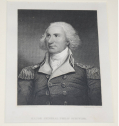site search
online catalog
1776 DS – MAJOR GENERAL PHILIP SCHUYLER

$500.00 SOLD
Originally $950.00
Quantity Available: None
Item Code: 766-12
Framed document signed by a Revolutionary War general. Dated “Feb 21st 1776”, the visible portion of the document measures 6 ¾” x 1 ¾”. Included in the frame is an engraving of Schuyler from a painting done by J. Trumbull and engraved by T. Kelly. Modern frame, 10 ¼” x 11 ¾”. Document is in very fine condition, with some soiling and staining. Ink is rather light in places, but all text is legible.
The document reads as follows:
“Capt Varick will please to examine the roll which Lieut. Springer[?] will deliver him, and if properly made up draw the rations on it.” Signed “P. Schuyler”, with date at lower left.
One of America's most influential early citizens and Alexander Hamilton's father-in-law, Schuyler was defeated in one of the earliest clashes between Hamilton and Aaron Burr -- the 1791 battle for one of New York's seats in the U.S. Senate. Schuyler was born into a prominent New York family in 1733. Like many early leaders, he established himself on the field of battle, in his case, during the French and Indian War (1755-60). He served in the New York State Assembly and the Second Continental Congress. When war broke out in 1775, he was commissioned as a general in the Continental Army. His career as a revolutionary was a less than glorious one. In an effort to clear his name after the fall of Fort Ticonderoga, he requested trial in a military court. He knew he would be proven innocent, and he was. His acquittal, however, did not completely repair his reputation.
After serving two terms in the New York senate and a term as a U.S. Senator representing New York, Schuyler was opposed for his Senate seat by Aaron Burr. The powerful Livingston and Clinton families, who were Schuyler's enemies, helped deliver victory to Burr. This infuriated Alexander Hamilton, who had married Schuyler's daughter Elizabeth and had backed his father-in law's candidacy. Hamilton was counting on Schuyler to support his economic platforms in the Senate. It was the first major battle between Hamilton and Burr. Following his defeat, Schuyler served another term as a state senator before retaking his U.S. Senate seat from Burr in 1797, thanks to Hamilton's renewed control of New York State's politics. Schuyler retired soon after and died in 1804, just few months after his son-in-law was killed by Aaron Burr.
The General Philip Schuyler House was built in 29 days in November 1777. This home is now part of Saratoga National Historical Park. During the American Revolution, the British Army occupied this area. The beautiful home of American General, Philip Schuyler, was burned to ground. Following the surrender of the British, General Schuyler lost no time in replacing his home. He rebuilt this house using much of the glass, nails, locks and hinges salvaged from the burned home. From here, the General ran his extensive business affairs. The Schuyler House was visited by many historic figures over the ages, including George Washington, Thomas Jefferson, James Madison, Marquis de Lafayette and President Franklin Roosevelt. Unlike many historic homes, this house was given to the U.S. Government as is. It has no electricity or running water and remains in much the same condition as it was in 1777.
~~~~~~~~~~~~~~~~~~~~~~~~~~~~~~~~~~~
THIS ITEM, AS WITH ALL OTHER ITEMS AVAILABLE ON OUR WEB SITE,
MAY BE PURCHASED THROUGH OUR LAYAWAY PROGRAM.
FOR OUR POLICIES AND TERMS,
CLICK ON ‘CONTACT US’ AT THE TOP OF ANY PAGE ON THE SITE,
THEN ON ‘LAYAWAY POLICY’.
Inquire About 1776 DS – MAJOR GENERAL PHILIP SCHUYLER
For inquiries, please email us at [email protected]
Most Popular
Historical Firearms Stolen From The National Civil War Museum In Harrisburg, Pa »
Theft From Gravesite Of Gen. John Reynolds »
Selection Of Unframed Prints By Don Troiani »
Fine Condition Brass Infantry Bugle Insignia »
British Imported, Confederate Used Bayonet »
Scarce New Model 1865 Sharps Still In Percussion Near Factory New »
featured item
EXCELLENT LARGE, ORIGINAL FRAMED OIL PAINTING OF 20TH MAINE’S JOSHUA LAWRENCE CHAMBERLAIN BY MICHAEL GNATEK
This is an original oil on canvas portrait of Major General Joshua L. Chamberlain of the 20th Maine Infantry done by the late Michael Gnatek. Mr. Gnatek received his art training at Yale University and in the Marine Corps, where he was a combat… (10-1968). Learn More »





